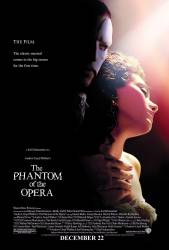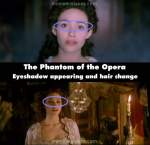Corrected entry: Christine has the Phantom's rose in her hands when she comes out on the Opera House's rooftop, but her hands were empty when she was climbing the stairs.
Corrected entry: The promotional posters and other material show a picture of the masked Phantom with Christine in his arms. The lighting and angles are very dramatic - seemingly enough so to justify sacrificing continuity, because the Phantom wears his mask on the left side of his face in this picture, while he wears a right-side mask for the whole of the film.
Correction: The idea of the poster is that they are looking in a mirror. It is not a mistake, just a clever depiction of his obsession.
Corrected entry: As the trap is set at the Paris Opera for the Phantom, armed police are seen arriving and it is evening but moments later inside the building Christine is in the chapel with bright sunshine streaming through the stained glass window.
Correction: The light shining through could very possibly be moonlight. As in Madame Giry's flashback we see a lot of moonlight shining down through the other gate on the opposite side of the chapel.
Corrected entry: When Raoul is running down the spiral stairs to the Phantom's lair to rescue Christine, the grate (that starts to come down on him) is visible below him. How did he get underneath the grate?
Correction: While running down the stairs, Raoul steps on a trap door and falls through it into the water, which is below the grate.
Corrected entry: When the movie begins and they are at the auction, it says "Paris, 1910"; however, at the end of it when Raoul goes to Christine grave (the same day of the auction), it says that she died in 1917.
Correction: It doesn't say '1910.' It says 'Paris, 1919.'
Corrected entry: When Christine leaves the opera house and asks for a carriage to the cemetery, she is wearing a white night gown. She gets a cloak, but by the time she gets to the cemetery she is wearing a full black dress.
Correction: We don't see what happens after she reaches for the cloak. She could have changed her clothes between then and when she gets into the carriage.
Corrected entry: During the scene in the chapel just before "Don Juan Triumphant", Raoul goes to see Christine. When he enters the room, he is wearing his sword. Just before he sits down the sword vanishes. He never moves enough to remove it, nor do we ever hear it hit the floor.
Correction: His sword would have been in a scabbard on a belt tied to his waist. Seeing as he is wearing a very long coat, the coat is most likely covering the sword.
Corrected entry: When Christine is singing "Think of me" and the camera view changes to show her in full costume later that night, it is quite obvious that there are stage lights (aka spotlights) shining on her. However, at the beginning of the film, we are told that the chandelier has been fitted with the "new electric light." If electric lights were new in the early 1900's, then they could not have been in use in 1870.
Correction: As could be seen during the transformation scene earlier (old to new), those aren't spotlights, but theatre lights, using candles/gaslight and reflectors.
Corrected entry: The date given in the film (flashback) is 1870. The Paris Opera House wasn't opened until 1875.
Correction: On the building it says "Opera populaire". This is not the Palais Garnier (the Paris Opera) but a fictitious opera house in Paris.
Corrected entry: During the scene where Raoul and the Phantom fight in the cemetery, Raoul gets a gash on his left arm that leaves his shirt looking bloody. After they leave the cemetery and go back to the Opera House, it is assumed that quite some times passes. During the Final Lair scene at the end, however, there is still the same bloodstain on Raoul's shirt. Being the rich Vicomte that he is, he should have been wearing a different shirt instead of the old, stained, ripped one.
Correction: Raoul is wearing a different shirt; when he is running to the lair and takes off his jacket you can see that there is no blood stain on it. His wound opened up again and started bleeding.
Corrected entry: Raoul buys the little music box to lay at Christine's grave - but in the film, he never had occasion to see it.
Corrected entry: We first see Carlotta in a rehearsal for the opera "Hannibal," that is supposed to open that same night. The directors request her to sing the aria from the third act, then the accident occurs, and Carlotta storms out. Christine takes over the aria, and it is decided she will perform on the first night. Then there is a cut to that first night, Christine singing the aria in question, but in a costume and in sets that have obviously nothing whatsoever to do with "Hannibal."
Corrected entry: In the 'present day' scenes at the beginning of the film, we see the run-down theatre, filled with cobwebs and debris, while it's being used for the auction. However, in the scenes set earlier, we see that the theatre was consumed by fire; but there are no signs of this in the scenes set later.
Correction: There are nearly 50 years between the main plot and the framing story. The opera house could have been restored after the fire and fallen into disuse during World War One.
Corrected entry: Meg has a fringe which keeps changing length. It starts off short at the beginning of the film, it then gets longer, but by the end of the film it is back to being very short.
Correction: Considering that the plot covers at least a few months, there is no reason why her hair shouldn't have grown, and that when the bangs grew too long, she had them cut to the former length.
Corrected entry: We are told that the Phantom has never left the opera house since he arrived there as a child, yet he somehow knows the exact route to the cemetery when disguised as the coach driver.
Correction: Just because the Phantom has "never left" the opera house since he was a child, that doesn't necessarily mean that he's there 24/7. Most likely, they are referring to the fact that the opera house has been his residence since he was a child.
Corrected entry: The Phantom breaks all the mirrors at the very end and the way the glass shatters shows that it is coated glass, which wasn't invented until 44 years after the movie was set. The movie was set in 1870 and coated glass was invented in 1914.
Correction: Silvered-glass coated mirrors were invented by German chemist Justus von Liebig in 1835; by 1870 the manufacturing process was automated and these mirrors were in common use.







Correction: If you look closely at her hands throughout the sequence the rose can be seen.